Section 33-2 Review Cnidaria and Ctenophora Answer Key
Invertebrates
143 Phylum Cnidaria
Learning Objectives
By the stop of this section, you will be able to do the following:
- Compare structural and organization characteristics of Porifera and Cnidaria
- Describe the progressive evolution of tissues and their relevance to animal complication
- Identify the two general body forms found in the Cnidaria
- Describe the identifying features of the major cnidarian classes
Phylum Cnidaria includes animals that exhibit radial or biradial symmetry and are diploblastic, pregnant that they develop from two embryonic layers, ectoderm and endoderm. Almost all (about 99 per centum) cnidarians are marine species.
Whereas the defining prison cell blazon for the sponges is the choanocyte, the defining jail cell type for the cnidarians is the cnidocyte, or stinging cell. These cells are located around the mouth and on the tentacles, and serve to capture prey or repel predators. Cnidocytes have large stinging organelles chosen nematocysts, which ordinarily contain barbs at the base of a long coiled thread. The outer wall of the prison cell has a hairlike projection called a cnidocil, which is sensitive to tactile stimulation. If the cnidocils are touched, the hollow threads evert with enormous dispatch, budgeted 40,000 times that of gravity. The microscopic threads then either entangle the prey or instantly penetrate the flesh of the prey or predator, releasing toxins (including neurotoxins and pore-forming toxins that can atomic number 82 to jail cell lysis) into the target, thereby immobilizing it or paralyzing information technology (see (Figure)).
Cnidocytes. Animals from the phylum Cnidaria have stinging cells called cnidocytes. Cnidocytes incorporate large organelles called (a) nematocysts that store a coiled thread and affront, the nematocyst. When the hairlike cnidocil on the cell surface is touched, even lightly, (b) the thread, barb, and a toxin are fired from the organelle.
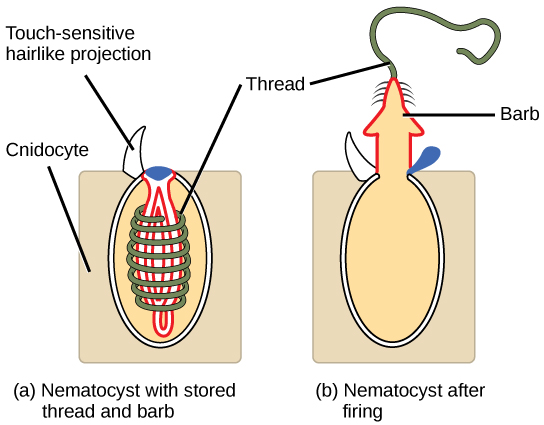
Link to Learning
View this video blitheness showing two anemones engaged in a battle.
Two distinct trunk plans are found in Cnidarians: the polyp or tuliplike "stem" form and the medusa or "bell" form. ((Effigy)). An example of the polyp form is found in the genus Hydra, whereas the most typical form of medusa is found in the group chosen the "sea jellies" (jellyfish). Polyp forms are sessile as adults, with a single opening (the oral fissure/anus) to the digestive cavity facing up with tentacles surrounding it. Medusa forms are motile, with the mouth and tentacles hanging down from an umbrella-shaped bong.
Cnidarian body forms. Cnidarians have two distinct body plans, the medusa (a) and the polyp (b). All cnidarians have ii membrane layers, with a jelly-like mesoglea between them.
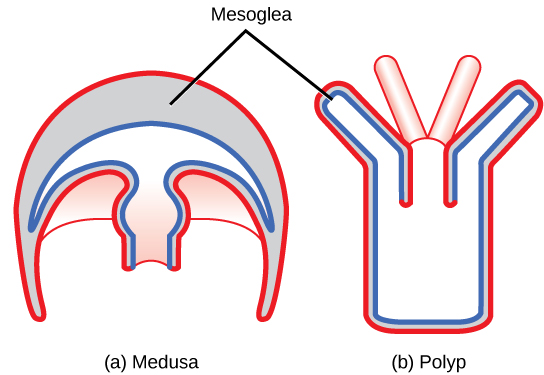
Some cnidarians are dimorphic, that is, they exhibit both body plans during their life bike. In these species, the polyp serves as the asexual phase, while the medusa serves as the sexual phase and produces gametes. However, both body forms are diploid.
An case of cnidarian dimorphism tin exist seen in the colonial hydroid Obelia. The sessile asexual colony has two types of polyps, shown in (Figure). The offset is the gastrozooid, which is adjusted for capturing prey and feeding. In Obelia, all polyps are connected through a mutual digestive cavity called a coenosarc. The other type of polyp is the gonozooid, adapted for the asexual budding and the product of sexual medusae. The reproductive buds from the gonozooid suspension off and mature into free-swimming medusae, which are either male or female (dioecious). Each medusa has either several testes or several ovaries in which meiosis occurs to produce sperm or egg cells. Interestingly, the gamete-producing cells practise not arise within the gonad itself, but migrate into it from the tissues in the gonozooid. This dissever origin of gonad and gametes is common throughout the eumetazoa. The gametes are released into the surrounding water, and after fertilization, the zygote develops into a blastula, which presently develops into a ciliated, bilaterally symmetrical planula larva. The planula swims freely for a while, but eventually attaches to a substrate and becomes a unmarried polyp, from which a new colony of polyps is formed by budding.
Obelia. The colonial sessile form of Obelia geniculata has two types of polyps: gastrozooids, which are adapted for capturing prey, and gonozooids, which asexually bud to produce medusae.
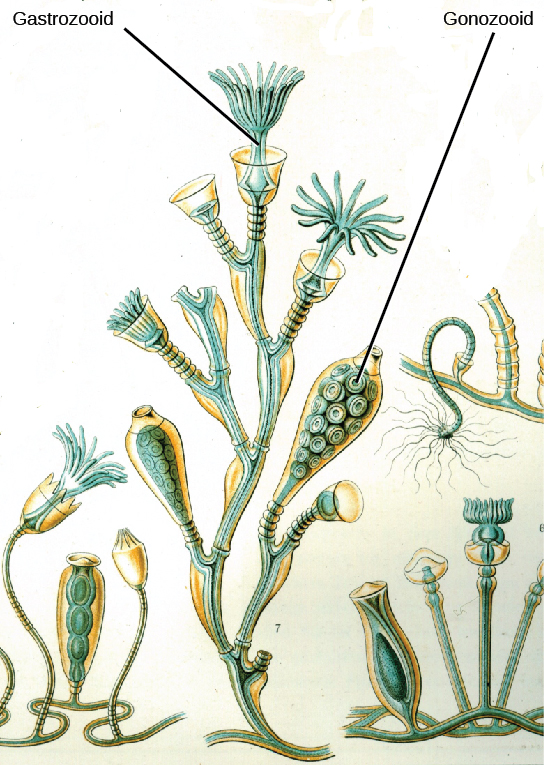
Link to Learning
Click hither to follow an Obelia life cycle animation and quiz.
All cnidarians are diploblastic and thus take 2 "epithelial" layers in the body that are derived from the endoderm and ectoderm of the embryo. The outer layer (from ectoderm) is called the epidermis and lines the outside of the animal, whereas the inner layer (from endoderm) is called the gastrodermis and lines the digestive cavity. In the planula larva, a layer of ectoderm surrounds a solid mass of endoderm, simply as the polyp develops, the digestive or gastrovascular cavity opens within the endoderm. A not-living, jelly-like mesoglea lies betwixt these two epithelial layers. In terms of cellular complexity, cnidarians show the presence of differentiated cell types in each tissue layer, such equally nerve cells, contractile epithelial cells, enzyme-secreting cells, and food-absorbing cells, as well as the presence of intercellular connections. However, with a few notable exceptions such every bit statocysts and rhopalia (see below), the evolution of organs or organ systems is not avant-garde in this phylum.
The nervous organisation is rudimentary, with nervus cells organized in a network scattered across the torso. This nerve cyberspace may prove the presence of groups of cells that form nerve plexi (singular: plexus) or nerve cords. Organization of the nervous system in the motile medusa is more circuitous than that of the sessile polyp, with a nervus band around the edge of the medusa bong that controls the action of the tentacles. Cnidarian nervus cells show mixed characteristics of motor and sensory neurons. The predominant signaling molecules in these primitive nervous systems are peptides, which perform both excitatory and inhibitory functions. Despite the simplicity of the nervous system, it is remarkable that information technology coordinates the complicated movement of the tentacles, the drawing of captured prey to the mouth, the digestion of food, and the expulsion of waste.
The gastrovascular crenel has only ane opening that serves as both a oral fissure and an anus; this system is chosen an incomplete digestive arrangement. In the gastrovascular cavity, extracellular digestion occurs as food is taken into the gastrovascular cavity, enzymes are secreted into the crenel, and the cells lining the cavity absorb nutrients. However, some intracellular digestion also occurs. The gastrovascular crenel distributes nutrients throughout the torso of the animal, with nutrients passing from the digestive cavity across the mesoglea to the epidermal cells. Thus, this cavity serves both digestive and circulatory functions.
Cnidarian cells commutation oxygen and carbon dioxide by improvidence between cells in the epidermis and water in the environment, and between cells in the gastrodermis and water in the gastrovascular crenel. The lack of a circulatory organisation to move dissolved gases limits the thickness of the trunk wall and necessitates a non-living mesoglea between the layers. In the cnidarians with a thicker mesoglea, a number of canals help to distribute both nutrients and gases. There is neither an excretory arrangement nor organs, and nitrogenous wastes simply lengthened from the cells into the h2o outside the animal or into the gastrovascular cavity.
The phylum Cnidaria contains most x,000 described species divided into two monophyletic clades: the Anthozoa and the Medusozoa. The Anthozoa include the corals, sea fans, sea whips, and the ocean anemones. The Medusozoa include several classes of Cnidaria in ii clades: The Hydrozoa include sessile forms, some medusoid forms, and swimming colonial forms similar the Portuguese man-of-state of war. The other clade contains various types of jellies including both Scyphozoa and Cubozoa. The Anthozoa contain only sessile polyp forms, while the Medusozoa include species with both polyp and medusa forms in their life bicycle.
Class Anthozoa
The class Anthozoa ("flower animals") includes sea anemones ((Figure)), body of water pens, and corals, with an estimated number of 6,100 described species. Ocean anemones are unremarkably brightly colored and can attain a size of 1.8 to 10 cm in diameter. Private animals are cylindrical in shape and are attached direct to a substrate.
Bounding main anemone. The sea anemone is shown (a) photographed and (b) in a diagram illustrating its morphology. (credit a: modification of work by "Dancing With Ghosts"/Flickr; credit b: modification of work by NOAA)
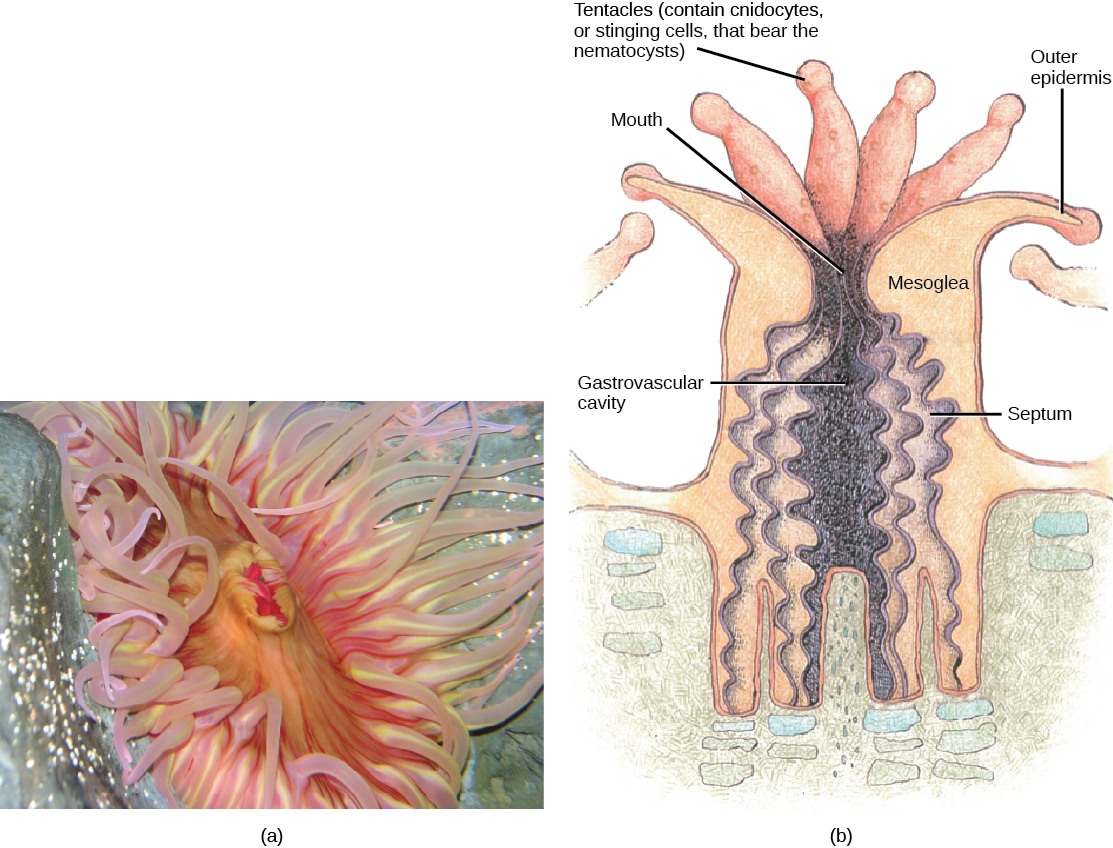
The mouth of a sea anemone is surrounded by tentacles that comport cnidocytes. The slit-like mouth opening and flattened pharynx are lined with ectoderm. This structure of the pharynx makes anemones bilaterally symmetrical. A ciliated groove chosen a siphonoglyph is found on two contrary sides of the pharynx and directs h2o into it. The pharynx is the muscular role of the digestive arrangement that serves to ingest likewise as egest food, and may extend for up to two-thirds the length of the body before opening into the gastrovascular cavity. This cavity is divided into several chambers by longitudinal septa chosen mesenteries. Each mesentery consists of a fold of gastrodermal tissue with a layer of mesoglea between the sheets of gastrodermis. Mesenteries practise not divide the gastrovascular crenel completely, and the smaller cavities coalesce at the pharyngeal opening. The adaptive benefit of the mesenteries appears to be an increase in surface area for absorption of nutrients and gas substitution, besides as additional mechanical support for the torso of the anemone.
Ocean anemones feed on pocket-size fish and shrimp, normally by immobilizing their prey with nematocysts. Some sea anemones establish a mutualistic human relationship with hermit crabs when the crab seizes and attaches them to their shell. In this relationship, the anemone gets food particles from prey caught by the crab, and the crab is protected from the predators by the stinging cells of the anemone. Some species of anemone fish, or clownfish, are too able to alive with bounding main anemones because they build up an acquired immunity to the toxins contained within the nematocysts and likewise secrete a protective mucus that prevents them from existence stung.
The structure of coral polyps is similar to that of anemones, although the private polyps are normally smaller and role of a colony, some of which are massive and the size of small buildings. Coral polyps feed on smaller planktonic organisms, including algae, leaner, and invertebrate larvae. Some anthozoans have symbiotic associations with dinoflagellate algae chosen zooxanthellae. The mutually benign relationship between zooxanthellae and modern corals—which provides the algae with shelter—gives coral reefs their colors and supplies both organisms with nutrients. This complex mutualistic association began more 210 million years ago, according to a new written report by an international team of scientists. That this symbiotic relationship arose during a time of massive worldwide coral-reef expansion suggests that the interconnection of algae and coral is crucial for the health of coral reefs, which provide habitat for roughly 1-fourth of all marine life. Reefs are threatened by a trend in ocean warming that has caused corals to expel their zooxanthellae algae and plow white, a process called coral bleaching.
Anthozoans remain polypoid (note that this term is easily confused with "polyploid") throughout their lives and can reproduce asexually by budding or fragmentation, or sexually by producing gametes. Male or female gametes produced past a polyp fuse to give rise to a gratuitous-swimming planula larva. The larva settles on a suitable substratum and develops into a sessile polyp.
Grade Scyphozoa
Class Scyphozoa ("cup animals") includes all (and only) the marine jellies, with about 200 known species. The medusa is the prominent stage in the life cycle, although there is a polyp stage in the life bicycle of nearly species. Most jellies range from 2 to 40 cm in length but the largest scyphozoan species, Cyanea capillata, can accomplish a size of two meters in bore. Scyphozoans display a characteristic bell-like morphology ((Figure)).
A sea jelly. A jelly is shown (a) photographed and (b) in a diagram illustrating its morphology. (credit a: modification of piece of work past "Jimg944″/Flickr; credit b: modification of work by Mariana Ruiz Villareal)
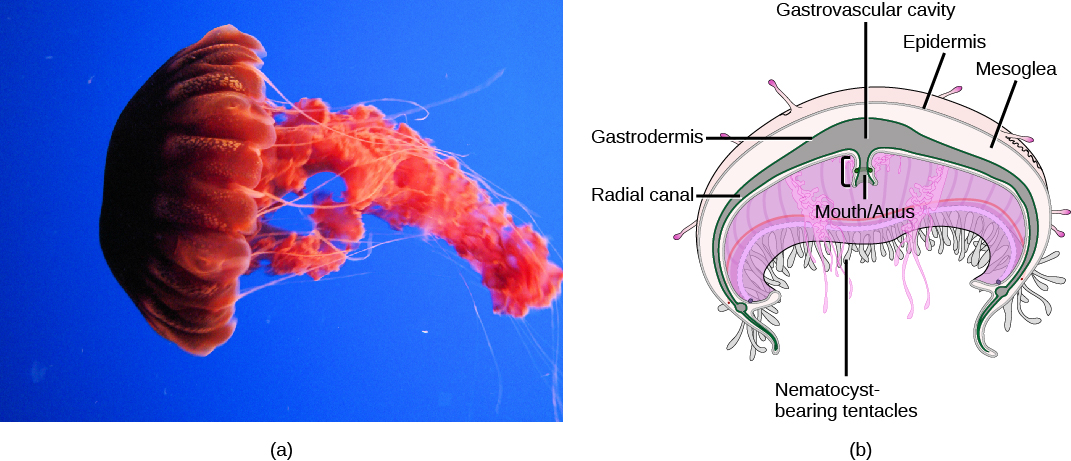
In the ocean jelly, a mouth opening is present on the underside of the animal, surrounded by hollow tentacles bearing nematocysts. Scyphozoans live nigh of their life cycle as costless-pond, solitary carnivores. The mouth leads to the gastrovascular cavity, which may be sectioned into four interconnected sacs, chosen diverticuli. In some species, the digestive system may co-operative further into radial canals. Like the septa in anthozoans, the branched gastrovascular cells serve two functions: to increment the surface expanse for nutrient assimilation and diffusion, and to support the torso of the animal.
In scyphozoans, nerve cells are organized in a nerve net that extends over the entire trunk, with a nerve ring effectually the edge of the bell. Clusters of sensory organs chosen rhopalia may be present in pockets in the edge of the bong. Jellies have a ring of muscles lining the dome of the trunk, which provides the contractile force required to swim through water, besides as to describe in food from the water as they swim. Scyphozoans have separate sexes. The gonads are formed from the gastrodermis and gametes are expelled through the oral fissure. Planula larvae are formed by external fertilization; they settle on a substratum in a polypoid course. These polyps may bud to course additional polyps or begin immediately to produce medusa buds. In a few species, the planula larva may develop directly into the medusa. The life cycle ((Figure)) of most scyphozoans includes both sexual medusoid and asexual polypoid body forms.
Scyphozoan life bicycle. The lifecycle of most jellyfish includes two stages: the medusa stage and the polyp stage. The polyp reproduces asexually by budding, and the medusa reproduces sexually. (credit "medusa": modification of work by Francesco Crippa)
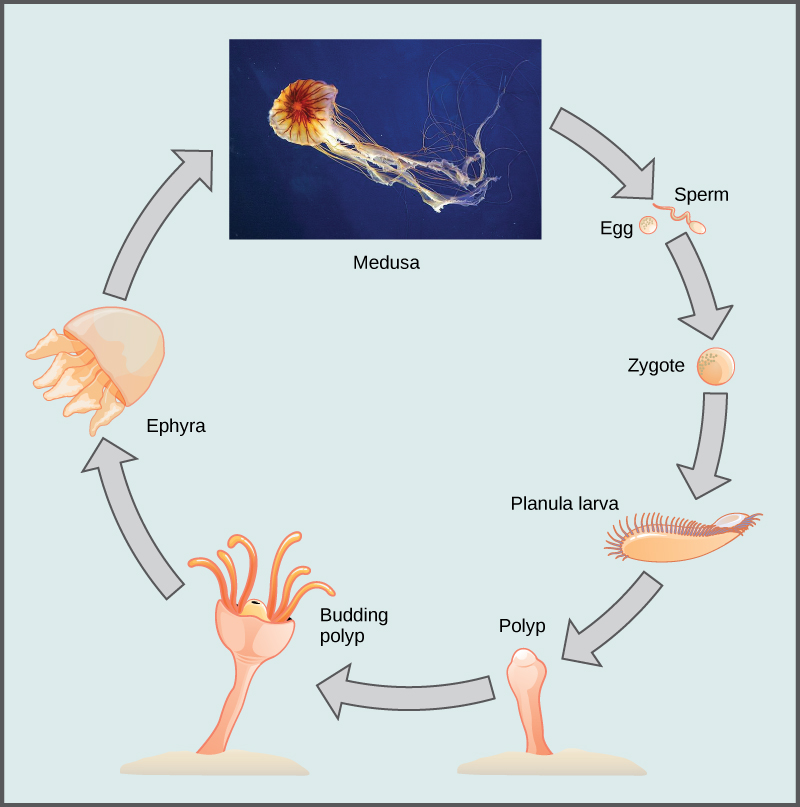
Class Cubozoa
This form includes jellies that take a box-shaped medusa, or a bell that is square in cross-department, and are colloquially known as "box jellyfish." These species may accomplish sizes of 15 to 25 cm, simply typically members of the Cubozoa are not every bit big equally those of the Scyphozoa. Yet, cubozoans brandish overall morphological and anatomical characteristics that are similar to those of the scyphozoans. A prominent deviation between the two classes is the organization of tentacles. The cubozoans contain muscular pads called pedalia at the corners of the square bell canopy, with one or more than tentacles attached to each pedalium. In some cases, the digestive system may extend into the pedalia. Nematocysts may be arranged in a spiral configuration along the tentacles; this arrangement helps to finer subdue and capture prey. Cubozoans include the nigh venomous of all the cnidarians ((Figure)).
These animals are unusual in having epitome-forming eyes, including a cornea, lens, and retina. Because these structures are made from a number of interactive tissues, they tin be called true organs. Eyes are located in four clusters between each pair of pedalia. Each cluster consists of four uncomplicated centre spots plus ii image-forming eyes oriented in dissimilar directions. How images formed by these very complex eyes are candy remains a mystery, since cubozoans have all-encompassing nerve nets but no distinct brain. Nontheless, the presence of eyes helps the cubozoans to exist active and effective hunters of small marine animals like worms, arthropods, and fish.
Cubozoans have split sexes and fertilization occurs inside the female. Planula larvae may develop inside the female or be released, depending on species. Each planula develops into a polyp. These polyps may bud to form more polyps to create a colony; each polyp then transforms into a single medusa.
A cubozoan. The (a) tiny cubozoan jelly Malo kingi is thimble-shaped and, like all cubozoan jellies, (b) has iv muscular pedalia to which the tentacles attach. K. kingi is i of two species of jellies known to crusade Irukandji syndrome, a condition characterized past excruciating muscle pain, vomiting, increased heart rate, and psychological symptoms. Two people in Commonwealth of australia, where Irukandji jellies are well-nigh unremarkably found, are believed to accept died from Irukandji stings. (c) A sign on a beach in northern Australia warns swimmers of the danger. (credit c: modification of work past Peter Shanks)
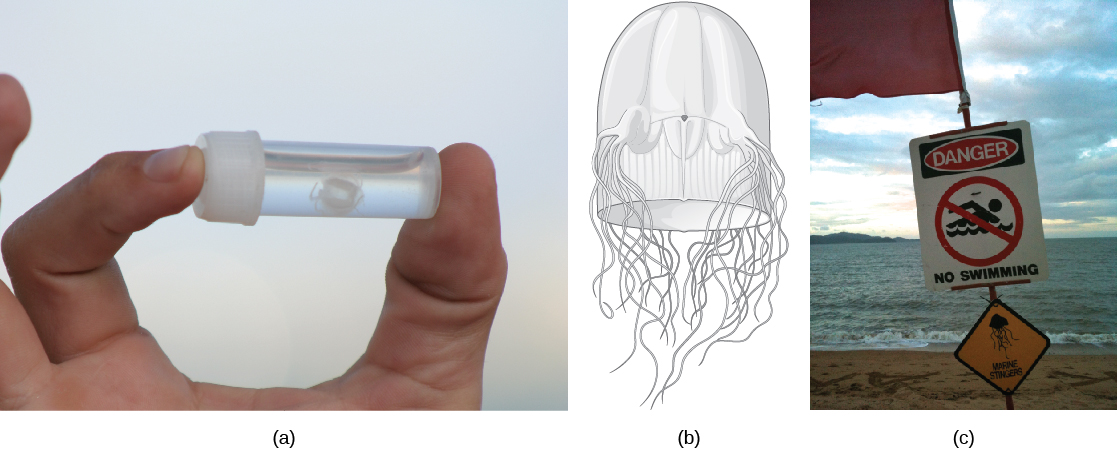
Course Hydrozoa
Hydrozoa is a diverse group that includes virtually three,200 species; nigh are marine, although some freshwater species are known ((Figure)). Most species exhibit both polypoid and medusoid forms in their lifecycles, although the familiar Hydra has just the polyp course. The medusoid grade has a muscular veil or velum below the margin of the bell and for this reason is chosen a hydromedusa. In dissimilarity, the medusoid class of Scyphozoa lacks a velum and is termed a scyphomedusa.
The polyp grade in these animals ofttimes shows a cylindrical morphology with a cardinal gastrovascular crenel lined by the gastrodermis. The gastrodermis and epidermis have a unproblematic layer of mesoglea sandwiched betwixt them. A mouth opening, surrounded by tentacles, is present at the oral end of the fauna. Many hydrozoans form sessile, branched colonies of specialized polyps that share a common, branching gastrovascular cavity (coenosarc), such as is found in the colonial hydroid Obelia.
Free-floating colonial species chosen siphonophores comprise both medusoid and polypoid individuals that are specialized for feeding, defence force, or reproduction. The distinctive rainbow-hued float of the Portuguese human o' war (Physalia physalis) creates a pneumatophore with which it regulates buoyancy by filling and expelling carbon monoxide gas. At kickoff glance, these complex superorganisms appear to be a single organism; but the reality is that fifty-fifty the tentacles are actually composed of zooids laden with nematocysts. Thus, although information technology superficially resembles a typical medusozoan jellyfish, P. physalis is a gratuitous-floating hydrozoan colony; each specimen is made upwardly of many hundreds of organisms, each specialized for a certain function, including motility and buoyancy, feeding, reproduction and defence. Although they are carnivorous and feed on many soft bodied marine animals, P. physalis lack stomachs and instead accept specialized polyps called gastrozooids that they apply to digest their prey in the open up water.
Physalia has male and female person colonies, which release their gametes into the water. The zygote develops into a single individual, which and then buds asexually to form a new colony. Siphonophores include the largest known floating cnidarian colonies such every bit Praya dubia, whose chain of zoids tin can get up to fifty meters (165 feet) long. Other hydrozoan species are lonely polyps (Hydra) or alone hydromedusae (Gonionemus). One defining characteristic shared by the hydrozoans is that their gonads are derived from epidermal tissue, whereas in all other cnidarians they are derived from gastrodermal tissue.
Hydrozoans. The polyp colony Obelia (a), siphonophore colonies Physalia (b) physalis, known as the Portuguese human o' war and Velella bae (c), and the solitary polyp Hydra (d) accept unlike body shapes but all vest to the family Hydrozoa. (credit b: modification of work by NOAA; scale-bar information from Matt Russell)
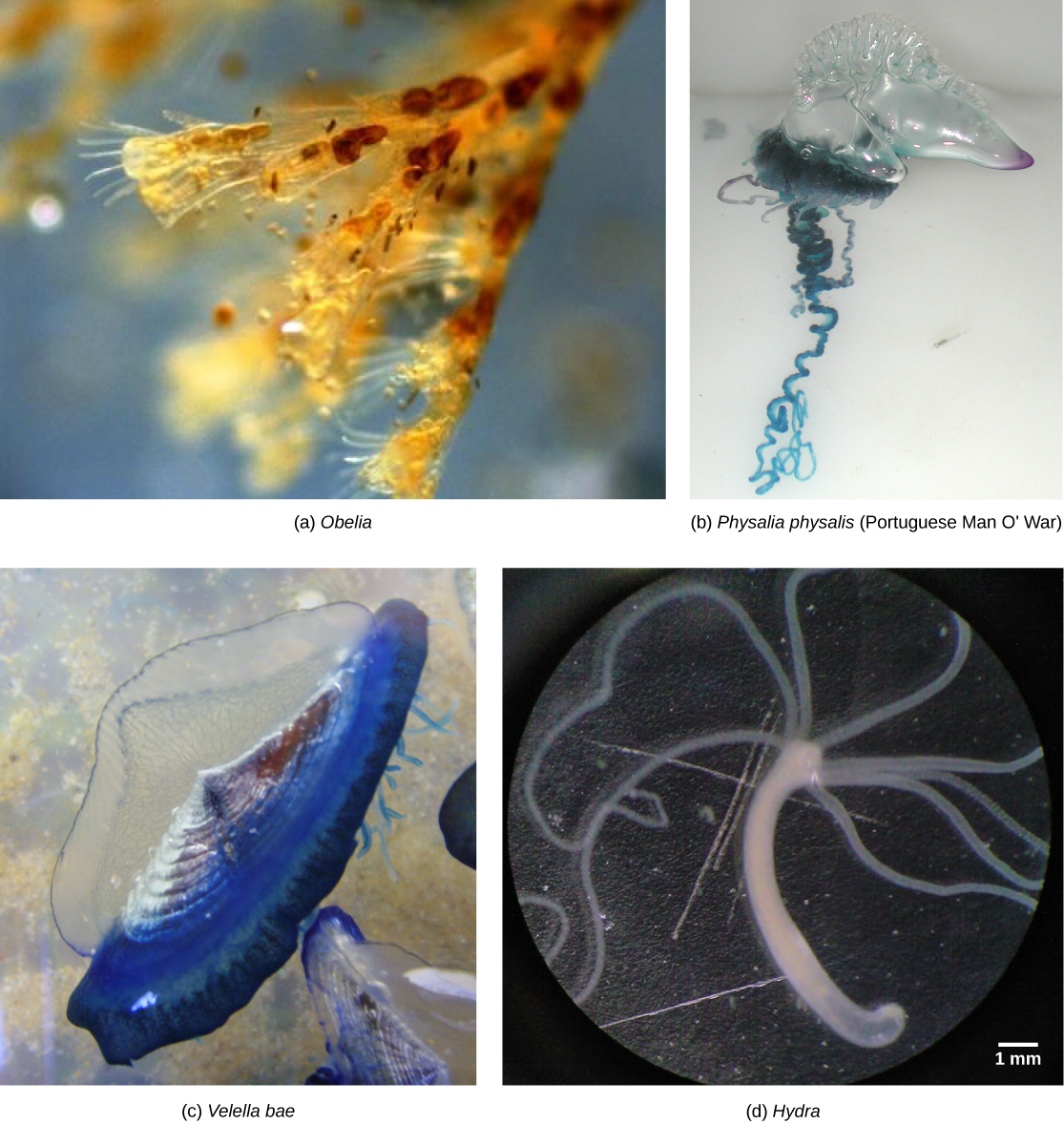
Section Summary
Cnidarians represent a more complex level of system than Porifera. They possess outer and inner tissue layers that sandwich a noncellular mesoglea between them. Cnidarians possess a well-formed digestive arrangement and carry out extracellular digestion in a digestive cavity that extends through much of the animal. The rima oris is surrounded past tentacles that contain big numbers of cnidocytes—specialized cells bearing nematocysts used for stinging and capturing prey equally well as discouraging predators. Cnidarians have separate sexes and many take a lifecycle that involves 2 singled-out morphological forms—medusoid and polypoid—at various stages in their life cycles. In species with both forms, the medusa is the sexual, gamete-producing stage and the polyp is the asexual phase. Cnidarian species include individual or colonial polypoid forms, floating colonies, or big private medusa forms (sea jellies).
Review Questions
Cnidocytes are establish in _____.
- phylum Porifera
- phylum Nemertea
- phylum Nematoda
- phylum Cnidaria
D
Cubozoans are ________.
- polyps
- medusoids
- polymorphs
- sponges
C
While collecting specimens, a marine biologist finds a sessile Cnidarian. The medusas that bud from it swim by contracting a band of muscle in their bells. To which form does this specimen vest?
- Course Hydrozoa
- Class Cubozoa
- Grade Scyphozoa
- Class Anthozoa
C
Critical Thinking Questions
Explain the role of nematocysts in cnidarians.
Nematocysts are "stinging cells" designed to paralyze prey. The nematocysts incorporate a neurotoxin that renders casualty immobile.
Compare the structural differences betwixt Porifera and Cnidaria.
Poriferans practice non possess true tissues, while cnidarians do take tissues. Because of this difference, poriferans do not have a nervous system or muscles for locomotion, which cnidarians have.
Compare the differences in sexual reproduction between Porifera and Cubozoans. How does the difference in fertilization provide an evolutionary advantage to the Cubozoans?
There are two key differences between Porifera (sponges) and Cubozoans (box jellyfish) – gamete production and fertilization strategy. Box jellyfish accept separate sexes, while a single sponge can produce both types of gametes. Box jellyfish also undergo internal fertilization, while sponges reproduce past external fertilization. Internal fertilization allows box jellyfish to control which sperm is used for fertilization and increases the likelihood of ova and spermatozoa meeting.
Glossary
- Cnidaria
- phylum of animals that are diploblastic and have radial symmetry
- cnidocyte
- specialized stinging cell found in Cnidaria
- epidermis
- outer layer (from ectoderm) that lines the outside of the fauna
- extracellular digestion
- food is taken into the gastrovascular crenel, enzymes are secreted into the crenel, and the cells lining the crenel absorb nutrients
- gastrodermis
- inner layer (from endoderm) that lines the digestive cavity
- gastrovascular crenel
- opening that serves as both a mouth and an anus, which is termed an incomplete digestive system
- medusa
- free-floating cnidarian body plan with mouth on underside and tentacles hanging downwards from a bell
- mesoglea
- non-living, gel-similar matrix present betwixt ectoderm and endoderm in cnidarians
- nematocyst
- harpoon-like organelle within cnidocyte with pointed projectile and poison to stun and entangle prey
- polyp
- stem-like sessile life form of a cnidarians with mouth and tentacles facing upward, usually sessile but may be able to glide along surface
- polymorphic
- possessing multiple body plans inside the lifecycle of a grouping of organisms
- siphonophore
- tubular structure that serves as an inlet for h2o into the mantle cavity
coppolawhichisatur.blogspot.com
Source: https://opentextbc.ca/biology2eopenstax/chapter/phylum-cnidaria/
Post a Comment for "Section 33-2 Review Cnidaria and Ctenophora Answer Key"